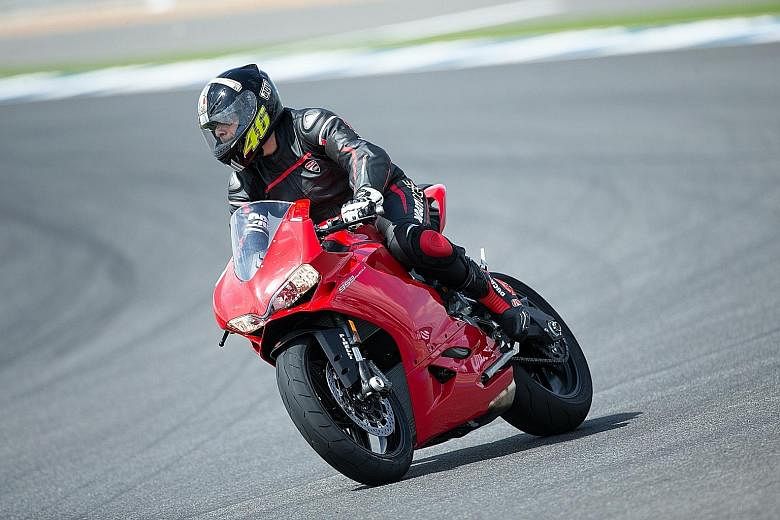Hunched over the sleek frame of the red superbike, helmet tucked behind the small windscreen to minimise wind resistance, I twisted the throttle and shifted into fourth gear. Speed: 120kmh.
A few seconds later, I found fifth gear, throttle still twisted wide open. Speed: 170kmh.
Another few seconds and the bike was in top gear. Speed: 200… 205… 210kmh.
And then a stream of red bikes screamed past me as though I was cruising leisurely down East Coast Parkway.
That was my first lesson in humility. But before we go any further down that path, let me explain what I was doing on this bike.
Ducati has just unveiled its latest product: the 959 Panigale. And, in a media launch befitting such a superbike, the Italian manufacturer assembled more than 20 of the gleaming red machines at the Buriram race track in Thailand late last month.
The media riders were divided into six groups, depending on track experience. Being a track virgin, I was part of the novice group of four. No complaints.
The day started out with our trainer showing us the best posture for the various riding situations.
On the straight, slide your butt to the back of the seat, grip the tank with your thighs and bend forward, chest close to the tank and helmet tucked under the windscreen. There is minimal wind resistance this way. Going into a right-hander, slide forward in the seat, lean into the turn with your upper body while anchoring your left thigh against the tank even as you point your right knee and right elbow in the direction of the turn. But it is easier said than done.
Flip the movements for a left-hander. That does not get any easier.
Once we got the hang of the riding positions, it was time to hit the track. The first outing was sedate, with the bike in Sport mode (it also has Wet and Race settings) and most of the electronic nannies such as three-stage anti-lock braking system, traction control and engine brake control at armed.
The trainer led the way, demonstrating the best lines around the 12-turn circuit. Top speed on the long straight: 120kmh. Easy peasy.
The next few sessions were a little more exploratory, with the trainer stepping things up a notch. He swept into corners a little faster and exited a lot faster. He even let us take turns behind him, so that each rider could learn from his lines. Top speed: 150kmh. No worries.
Then came the real stuff. The bike was clicked into Race mode: Heightened throttle and engine response, electronic nannies partly disabled. And the trainer took off the gloves (well, figuratively). He asked each of us to take turns in leading the convoy, allowing us the freedom to set the pace. Not such a good idea.
Fuelled by the confidence garnered in the earlier sessions, each of the four novices got himself into enough butt-clenching OMG moments to warrant a trip to the dry cleaners. But the Panigale's magnificent Brembo brakes reined us in safely when we overcooked things, and its excellent Pirelli Diablo Rosso Corsa tyres kept the bike upright when things got squirrelly under heavy braking.
Through all this, I was given a few more lessons in humility.
I learnt that MotoGP riders cannot be human. Here I was, dripping with sweat and exhausted, almost grateful when the chequered flag waved to end our six-lap sessions. And MotoGP riders clock more than 20 laps at each race, going 350kmh on the straight and scraping knee- and elbow-sliders in the corners.
I learnt that the 959 Panigale is a gracious and forgiving machine. But it is equally sobering when you miss your braking point for a hairpin bend and end up grabbing a fistful of front brake. This bike almost intuitively adjusts its centre of gravity, permits frantic downshifts that do not mash its Superquadro engine and leans over to permit yet another search for the apex.
And, most importantly, I learnt that speed is relative. One minute you are doing the highest speed you can manage and feeling quite smug as you see 210kmh come up on the digital speedo. Next minute, you are being passed by the more experienced riders who later tell you they were searching for more speed at 250kmh.
• The writer is an occasional contributor to The Straits Times.

